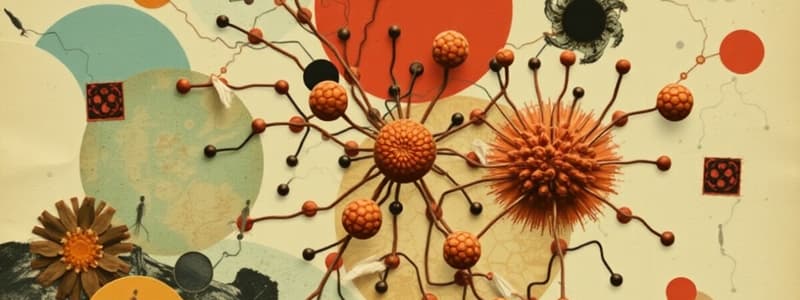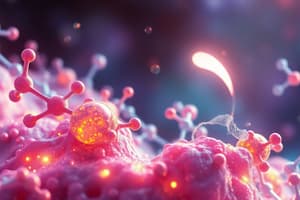Podcast
Questions and Answers
The three isotopes of carbon 12C, 13C and 14C have different numbers of _____?
The three isotopes of carbon 12C, 13C and 14C have different numbers of _____?
neutrons
Organic macromolecules can be found in living things, contain carbon and hydrogen and can be polymers made up of monomers?
Organic macromolecules can be found in living things, contain carbon and hydrogen and can be polymers made up of monomers?
True (A)
The shape of protein is affected by
The shape of protein is affected by
- pH
- Exposure to chemicals
- Temperature
- All of the above (correct)
Amino acids are the monomers (basic subunit) for
Amino acids are the monomers (basic subunit) for
All of the chemical reactions that take place within your body are known as
All of the chemical reactions that take place within your body are known as
All of the following are characteristics of life EXCEPT
All of the following are characteristics of life EXCEPT
The atomic number of an atom is the same as _____.
The atomic number of an atom is the same as _____.
Radioactive isotopes are used to determine the age of fossils, trace chemicals during biochemical reactions and detect thyroid abnormalities?
Radioactive isotopes are used to determine the age of fossils, trace chemicals during biochemical reactions and detect thyroid abnormalities?
Which sequence correctly lists levels of organization from simple to more complex?
Which sequence correctly lists levels of organization from simple to more complex?
Which of the following carbohydrates is not found in plants?
Which of the following carbohydrates is not found in plants?
Cell theory states that:
Cell theory states that:
_____ is what the scientist measures to determine whether the independent variable influenced the phenomenon of interest.
_____ is what the scientist measures to determine whether the independent variable influenced the phenomenon of interest.
A sugar is an example of a _____ molecule while a molecule of DNA is a _____.
A sugar is an example of a _____ molecule while a molecule of DNA is a _____.
Which property of water is specifically attributed to its polarity and hydrophilic nature?
Which property of water is specifically attributed to its polarity and hydrophilic nature?
PH of 7 is _____.
PH of 7 is _____.
Flashcards
Isotopes
Isotopes
Atoms of the same element with different numbers of neutrons.
Organic Macromolecules
Organic Macromolecules
Large, complex molecules essential for life, containing carbon and hydrogen.
Factors Affecting Protein Shape
Factors Affecting Protein Shape
pH, exposure to chemicals, and temperature.
Amino Acids' Role
Amino Acids' Role
Signup and view all the flashcards
Metabolism
Metabolism
Signup and view all the flashcards
Not a universal characteristic of life
Not a universal characteristic of life
Signup and view all the flashcards
Atomic Number
Atomic Number
Signup and view all the flashcards
Uses of Radioactive Isotopes
Uses of Radioactive Isotopes
Signup and view all the flashcards
Levels of Organization (Simple to Complex)
Levels of Organization (Simple to Complex)
Signup and view all the flashcards
Glycogen
Glycogen
Signup and view all the flashcards
Cell Theory
Cell Theory
Signup and view all the flashcards
Dependent Variable
Dependent Variable
Signup and view all the flashcards
Sugar vs. DNA Molecule
Sugar vs. DNA Molecule
Signup and view all the flashcards
Water as a Solvent
Water as a Solvent
Signup and view all the flashcards
Neutral pH (pH 7)
Neutral pH (pH 7)
Signup and view all the flashcards
Neutrons Role
Neutrons Role
Signup and view all the flashcards
Organic Macromolecules Characteristics
Organic Macromolecules Characteristics
Signup and view all the flashcards
Environmental protein impact
Environmental protein impact
Signup and view all the flashcards
how proteins get special
how proteins get special
Signup and view all the flashcards
Metabolism's purpose
Metabolism's purpose
Signup and view all the flashcards
Life's key characteristcs
Life's key characteristcs
Signup and view all the flashcards
Use of radio active isotopes
Use of radio active isotopes
Signup and view all the flashcards
organization of the body
organization of the body
Signup and view all the flashcards
Glycogen's role
Glycogen's role
Signup and view all the flashcards
Summary of cell theory
Summary of cell theory
Signup and view all the flashcards
Dependent variable
Dependent variable
Signup and view all the flashcards
Sugar type
Sugar type
Signup and view all the flashcards
Propoerty of water?
Propoerty of water?
Signup and view all the flashcards
PH OF 7
PH OF 7
Signup and view all the flashcards
Gene's function
Gene's function
Signup and view all the flashcards
Study Notes
- Carbon isotopes 12C, 13C, and 14C differ in the number of neutrons.
- Organic macromolecules can be found in living things, contain carbon and hydrogen, and can be polymers made of monomers.
- pH, exposure to chemicals, and temperature affect the shape of a protein.
- Amino acids are the monomers (basic subunits) for proteins.
- All the chemical reactions that occur within the body are known as metabolism.
- Movement is a characteristic of life
- The atomic number of an atom is the same as the number of protons the atom has.
- Radioactive isotopes can determine the age of fossils, trace chemicals during biochemical reactions and detect thyroid abnormalities.
- The levels of organization from simple to more complex are: cell, tissue, organ, organ system, organism.
- Glycogen is a carbohydrate not found in plants.
- Cell theory states that all living organisms consist of cells, and all cells come from other cells.
- The dependent variable is what the scientist measures to determine whether the independent variable influenced the phenomenon of interest.
- A sugar is a carbohydrate molecule while a molecule of DNA is a nucleic acid.
- Water is a solvent which is attributed to its polarity and hydrophilic nature.
- A pH of 7 is neutral.
Studying That Suits You
Use AI to generate personalized quizzes and flashcards to suit your learning preferences.
Related Documents
Description
This lesson covers carbon isotopes, organic macromolecules, and the factors affecting protein shape. It also reviews the characteristics of life, levels of organization, and cell theory, providing a foundational understanding of key biological concepts.




